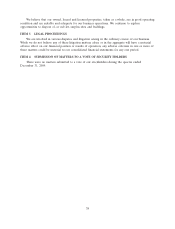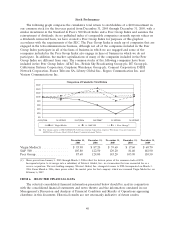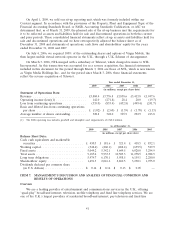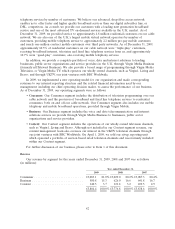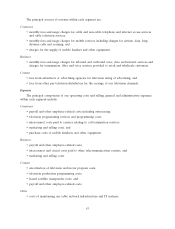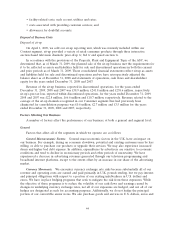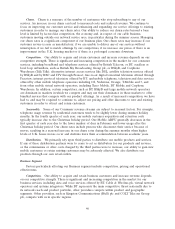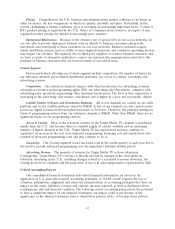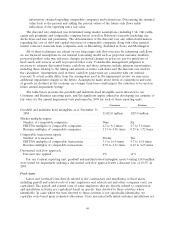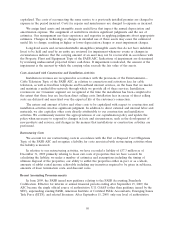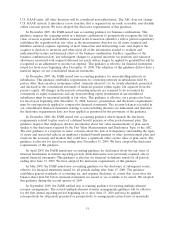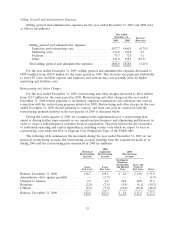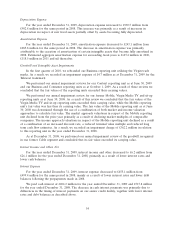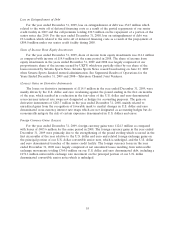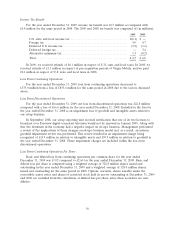Virgin Media 2009 Annual Report Download - page 50
Download and view the complete annual report
Please find page 50 of the 2009 Virgin Media annual report below. You can navigate through the pages in the report by either clicking on the pages listed below, or by using the keyword search tool below to find specific information within the annual report.require more judgment and estimation than other matters owing to the uncertainty related to
measuring, at a specific point in time, transactions that are continuous in nature.
These policies may need to be revised in the future in the event that changes to our business
occur.
Impairment of Indefinite-Lived Assets
Goodwill arising from business combinations, reorganization value in excess of amounts allocable
to identifiable assets and intangible assets with indefinite lives, are subject to annual review for
impairment (or more frequently should indications of impairment arise). Impairment of goodwill and
reorganization value in excess of amounts allocable to identifiable assets is determined using a two-step
approach, initially based on a comparison of the reporting unit’s fair value to its carrying value; if the
fair value is lower than the carrying value, then the second step compares the asset’s fair value (implied
fair value for goodwill and reorganization value in excess of amounts allocable to identifiable assets)
with its carrying value to measure the amount of the impairment. Impairment of intangible assets with
indefinite lives is determined based on a comparison of fair value to carrying value. Any excess of
carrying value over fair value is recognized as an impairment loss. We incurred impairment charges in
2008 in respect of our former Mobile and sit-up reporting units, and we may incur further impairment
charges if, for example, market values decline or we do not achieve expected cash flows.
As a result of the business reorganization initiated in 2008, we have realigned our internal
reporting structure and the related financial information used by management and the chief operating
decision maker. During the first quarter of 2009, our operating structures were revised with a view to
building a customer-focused organization able to respond effectively to rapid changes in the market,
technology and customer demands through our three new customer-based segments: Consumer,
Business and Content. Accordingly, we now have three reporting units consisting of Consumer,
Business and Content. Our Content reporting unit is evaluated for impairment purposes as at June 30,
while the Consumer and Business reporting units are evaluated as at October 1 of each year.
While we utilize a variety of valuation techniques to determine fair value, including market
multiples and comparable transactions, estimated fair value is generally measured by discounting
estimated future cash flows. The following discussion summarizes each approach used to determine fair
value and how it has been utilized by us:
–Market Multiple Approach—This method provides indications of value based upon comparisons
of the reporting unit to market values and pricing evidence of public companies involved in the
same or similar lines of business. Market ratios (pricing multiples) and performance
fundamentals relating to the public companies’ stock prices (equity) or enterprise values to
certain underlying fundamental data are applied to the reporting unit to determine its fair value.
We utilize publicly available information regarding comparable companies which operate in
North America and Europe.
–Comparable Transaction Approach—This method includes an examination of recent mergers and
acquisitions which involves companies in the same or similar lines of business to the reporting
unit. Acquisition values and pricing evidence are used in much the same manner as the Market
Multiple Approach for the determination of the reporting unit’s fair value.
–Discounted Cash Flow Approach—This method calculates the present value of the projected
future cash flows to be generated by the reporting unit using appropriate discount rates. The
discount rates are intended to reflect all associated risks of realizing the projected future cash
flows. Terminal value is computed as of the end of the last period for which cash flows are
projected utilizing a terminal multiple to determine an estimate of the value of the reporting
unit as of that future point in time. The terminal multiple employed is estimated utilizing the
48


